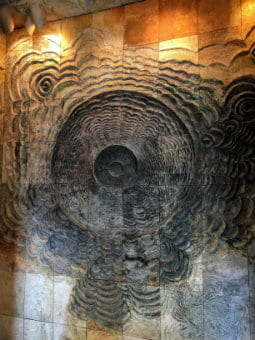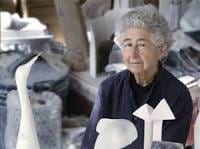Earth, Water, Sky
Ruth Duckworth (1919–2009)

Commissioned 1965
Installed 1967–68
Ceramic mural
400 square feet, covering four walls and the ceiling
Located in the entrance to the Henry Hinds Laboratory for Geophysical Sciences
5734 S. Ellis Avenue
Commissioned in the name of the University of Chicago by Julian Goldsmith, Chairman of the Geophysical Sciences Department; Presented to the University in honor of Jane H. Sherr by the Leonard J. Horwich Family
Earth, Water, Sky, a ceramic mural featuring abstracted weather patterns, rock formations, and topographical views, lines the entryway to the Henry Hinds Laboratory for Geophysical Sciences. This 10’ x 10’ x 10’ space is covered in over 400 tiles with fluid, biomorphic ceramic shapes that would characterize Ruth Duckworth’s long subsequent career as a sculptor. Duckworth joined the faculty at Midway Studios in 1964 and within a year she secured the commission for the mural from Julian Goldsmith, chairman of the Geophysical Sciences department. The mural would be for the department’s new home in a building designed by I.W. Colburn. In 1966 Goldsmith wrote a letter to alumni about the then–incomplete project:
As one walks into the building, he will pass through its essence. […] I think it will be stunning, for not only do I consider Mrs. Duckworth to be one of the world’s leading art–ceramists, but she has spent a great deal of time prowling in our library and looking at rocks, minerals, landscapes, waves and weather, on our behalf.
Duckworth, who did indeed study weather satellite images and topographical maps, planned the mural with Colburn and both mural and building were completed in 1969. The final mural features glass-filled craters, white cylindrical tubes encasing lights on the ceiling, swirling “fin-like” wedges, and the large cinder cone shape of Mt. Fuji composed of concentric circles.
Earth, Water, Sky was Duckworth’s first large commission and would ultimately convince her to stay in Chicago, where she remained until her death in 2009. The mural also led to two other large mural commissions in the Chicago area, Clouds Over Lake Michigan in German Dresdner Bank (1976) and The Creation in Congregation Beth Israel synagogue in Hammond, Indiana (1984).
Sources
Oral history interview with Ruth Duckworth, 2001 April 27, Archives of American Art, Smithsonian Institution
Carter, Karen, and Crystal Productions. Ruth Duckworth, a Life in Clay. Glenview, IL: Crystal Productions, 2002
Duckworth, Ruth, and Alice Westphal. Ruth Duckworth. Evanston, IL: Distributed by Exhibit A, Gallery of American Ceramics, 1977
Further Reading
Lauria, Jo., and Tony. Birks. RuthDuckworth: Modernist Sculptor. Aldershot: Lund Humphries, 2004
Galusha, Emily, Mary Ann Nord, and Minn.) Northern Clay Center (Minneapolis. Clay Talks: Reflections by American Master Ceramists: Regis Masters Series 1997-2000. Minneapolis, MN: Northern Clay Center, 2004

